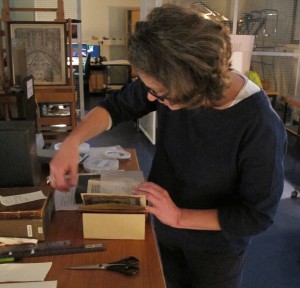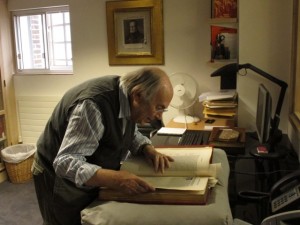
A member of the Library’s Conservation department prepares a Book of Hours printed on vellum for photography
To mark the end of the five-year incunabula cataloguing project, Ed Potten and Emily Dourish are editing a volume of essays on some of the treasures of the Library’s early printed holdings. 60 distinguished authors have submitted their pieces (see earlier posts on visits from Sir Quentin Blake and Sir David Attenborough) and the task of creating the page layouts is well under way. The final batch of books was taken to the photography studio last week, and some 400 images have been produced in total for the catalogue and other projects. These images will be of immense value in the future, for teaching, research and publicity purposes, and we are very fortunate to have an in-house Digital Content Unitand a very experienced Conservation team to assist with their creation. Continue reading 'New technologies and old; photographing incunabula'»

Sir Quentin examining the Sabellicus.
The Incunabula Cataloguing Project Team was delighted yesterday to welcome the renowned illustrator and author Sir Quentin Blake, accompanied by art education consultant Ghislaine Kenyon, on a visit to the Library.
In 2014, CUL proposes to publish an illustrated monograph containing a collection of 60 short articles penned by invited experts, discussing items from the incunabula collections. The authors have been selected to represent as wide a demographic as possible, with artists, poets, scientists and medics alongside incunabulists and typographers.

The arms of the Cornaro family.
Sir Quentin has very kindly agreed to contribute an article on one of our most remarkable decorated books, and visited yesterday to peruse it.
SSS.2.3 is a beautiful crisp copy of the Venice edition of Sabellicus’s Decades rerum Venetarum, printed by Andreas Torresanus, de Asula, 21 May 1487 (ISTC is00005000).

Initial on a3 recto
The CUL copy was clearly intended for presentation, and aimed at a patron of some standing. Leaf a3 recto is richly decorated with the arms of the Cornaro, one of Venice’s patrician families, held aloft by a slim triton and winged putto. There are a further thirty-five historiated faceted initials, mostly drawn in pen and set against a coloured background, depicting architectural motifs, figures and animals. These superb initials have been attributed by Lilian Armstrong to the Pico Master.
Sir Quentin spent a happy couple of hours examining the book with Laura Nuvoloni, the Project Cataloguer, and we eagerly await his submission.



